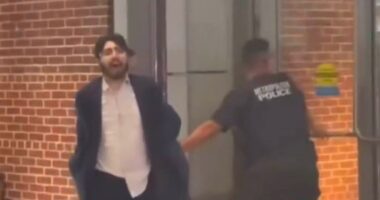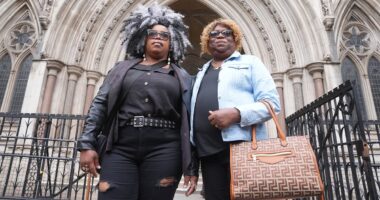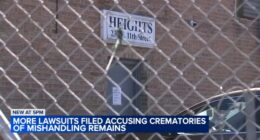NEIGHBORS are battling an HOA as it mulls plans to either exterminate or relocate a vital species deemed an invasive “pest.”
Campaigners warn that if the organization has its way the burrowing “barking” squirrels will be wiped out by urban sprawl.




The Harvest Junction Village Homeowners Association located in Longmont, Colorado has caused controversy among residents due to their decision to address a prairie dog colony issue.
CBS News reported on Monday that some neighbors consider the animals as “pests.”
The broadcaster added: “It’s not clear if the HOA is seeking quotes for relocation or extermination of the animals.”
Detractors fear the prairie dogs will spread disease within the community, said CBS.
The HOA has reportedly told residents that it fears legal action by homeowners against the association over the critters’ “encroachment.”
Jaime Fraina, a passionate advocate for wildlife, has taken a stand to protect these animals. He managed to collect $3,000 through a fundraising campaign on GoFundMe to assist in relocating the prairie dogs if necessary.
Another possible alternative to their extermination is to build a special barrier, he said.
Fraina has always found joy in observing the prairie dogs emerge from their burrows as he strolls along a path by Left Hand Creek in Longmont. This area offers breathtaking views of the nearby Rockies.
He said on Facebook: “I’ve walked in this park since before the HOA even existed.
“I’m not part of the HOA – the public park is now their private park.
“I don’t want to see these little guys killed as they mean a lot to me.”
Fraina told Westworld that people had incorrectly blamed the prairie dogs after the HOA had to replace 44 trees last year.
He said: “It was all poor irrigation. It was all planting incorrectly and various other issues that caused this.
“But people like to just put the blame on these little critters because there’s a lot of other misinformation out there about them.”
Fraina told CBS that he had urged the HOA to save the animals – which are considered a keystone species as many other species, both plant and animal, depend upon them for survival.
Black-footed ferrets eat prairie dogs exclusively. Also, the burrow of these animals – known as “barking” squirrels – provide shelter for a range of other species including burrowing owls and rattlesnakes.
He said: “Relocation I mentioned would be free for them. We can cover all the costs – we have a relocator.
“They [prairie dogs] would go toward Pueblo [south of Denver], most likely, where they would help the black-footed ferret, which is the most endangered species in North America.
“But also, if we want to contain them, there are better barriers we could build. So the HOA may actually profit if they just leave these guys alone.”
What is an HOA?

One in five Americans lives in an area with a Homeowners’ Association – or HOA. But what exactly is it that they do?
- An HOA is a homeowner’s association – an organization that aims to maintain a clean and cohesive place to live for its residents.
- Entire neighborhoods, subdivisions, condominiums, family homes, or townhouses within “a planned development” will often make up an HOA.
- They also act as a governing body for tenants, who run and fund the HOA through monthly fees.
- Their principal aims are to keep the community functioning and visually appealing and to maintain property values.
- They primarily focus on common areas of a neighborhood, such as roads, parks, and pools – but may also stipulate what residents can do with their properties, such as yards and driveways.
- Often these restrictions enforce uniformity on properties, for example, ensuring most houses look the same and all driveways are clear of weeds.
- An HOA rulebook of covenants, conditions, and restrictions (CC&R) is distributed to all residents, and an elected volunteer board of directors enforces these regulations.
- Breaking these rules can result in penalties such as fines and even litigation – as most HOAs are incorporated and subject to state law.
- HOAs are often the subject of controversy, with some members feeling that the rules are too punitive and restricting, or that the leadership has too much power.
- But others like that HOAs give communities the power of self-governance, and can ensure a degree of harmony between residents.
Fraina said that when they “protect each other and chirp when people come by, they’re so sweet.
“We’ve seen rabbits using their burrows, even toads potentially could be using their burrows.”
Eva Garon, a Harvest Junction Village resident, told the broadcaster that she lives across the street from the colony.
She said her son, two, “loves to see them, and they make us happy, and they’re cute.”
The broadcaster contacted the HOA for comment.
CBS cited an email it claimed the association had sent to residents, in which it alleged that, “a lot of misinformation has been spread” about its discussions.
Prairie dogs

Prairie dogs are “barking” squirrels, not dogs.
Three species live in Colorado: the black-tailed prairie dog; the white-tailed prairie dog and Gunnison’s prairie dog. The black-tailed are the most common.
Prairie dogs are tan or light brown (the color of sand or dirt), to blend in with their habitat so raptors do not see them from the sky.
Prairie dogs living in colonies – called towns – that can occur in agricultural, rural, suburban, and even urban areas.
They host the kind of fleas that carry plague.
They can carry a number of bacteria harmful to people or pets in their mouths (including tetanus) and bites can lead to serious infections in humans and animals.
These creatures are a major target as prey – with many different animals eating them due to their small size, such as coyotes, bobcats, badgers, foxes, rattlesnakes, and birds of prey.
Prairie dogs are considered a keystone species because of the burrowing networks they build.
That’s because they get eaten, make homes for other animals, and clip vegetation.
Sources: Colorado Parks & Wildlife and the National Park Service
According to the broadcaster, the HOA told residents that a board meeting had spoken about “prairie dog mitigation.”
The email reportedly added: “The primary reasons for mitigation are: destruction of vegetation and encroachment into homeowners’ property could result in legal action by homeowner(s) against the Association.
“The City was contacted about obtaining a permit and they agreed since part of the colony is on their property, coordination will be required between both of us.
“Four prairie dog remediation contractors have been contacted and price estimates for removal have been obtained.”
The HOA allegedly also said in the email that as it was already working with the City, “and since the Association is a private nonprofit the issue will be addressed within the community.”
The U.S. Sun has contacted the organization for comment.

















